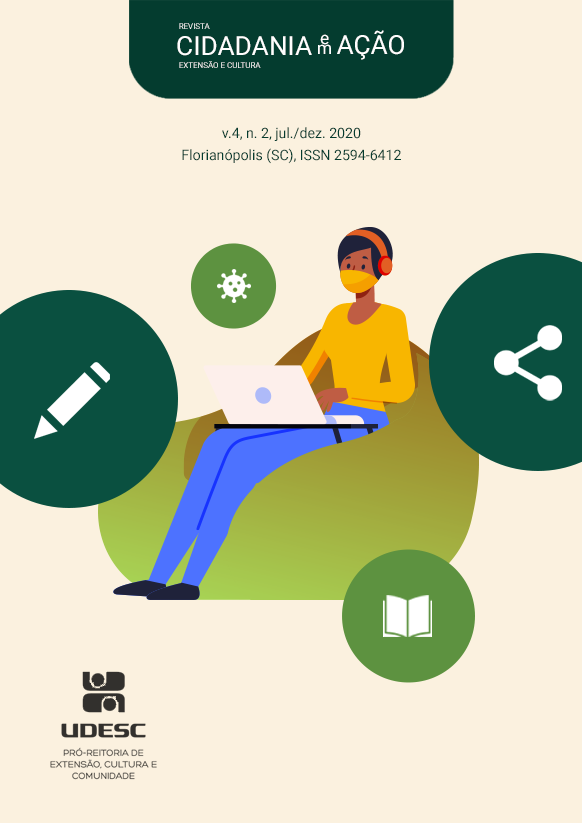Dando vez e voz aos alunos da EJA: promovendo um fazer matemático dinâmico
DOI:
https://doi.org/10.5965/259464124227Palavras-chave:
educação de jovens e adultos, matemática, material impresso, jogosResumo
Este artigo é fruto da escuta realizada no início do ano letivo de 2019 com os alunos da Educação de Jovens e Adultos - EJA, Ensino Médio, do Colégio Polivalente de Caravelas. A fim de tornar mais atraente e dinâmica a Matemática desenvolvida nesta modalidade de educação, o presente trabalho tem como objetivo mostrar o uso do material impresso e do jogo, como possibilidades didático-pedagógicas de construção do conhecimento matemático. São muitos os alunos desta turma que desenvolveram reações repulsivas em relação a este campo do saber. Nesta interação, contatou-se de que a forma que esta área do conhecimento foi apresentada para estes discentes contribuiu negativamente, tornando-a desinteressante. Por esta razão, optou-se no desenvolvimento de uma prática de ensino e aprendizagem baseado em elementos que estimulassem, viabilizassem e favorecessem o relacionamento destes alunos com os conceitos e ideias matemáticas. Para isso, apoia-se tanto em Freire (1996), que defende uma educação baseada no principio da dialogicidade, na prática da escuta, no querer bem ao educando, quanto em Muniz (2001), que propõe uma educação matemática a partir de situações ligadas aos jogos, ao uso de materiais impressos, dentre outros, como contextos favoráveis ao conhecimento matemático. Nesta fundamentação, também foram enfatizadas orientações que refletem a EJA na Bahia. Os resultados das atividades aplicadas comprovam que quando aprendemos assim, através do jogo e do uso do material impresso, os conteúdos matemáticos tem grandes chances de serem incorporados mais naturalmente e facilmente, o que de certa forma favorece o seu entendimento, a sua compreensão.
Downloads
Referências
BAHIA. Política de EJA da rede estadual. Salvador: SEC, 2009.
BRASIL. Parâmetros Curriculares Nacionais de Matemática para 3° e 4° ciclos. Brasília: MEC/SEF, 1998.
BRASIL. Base Nacional Comum Curricular. A área de Matemática e suas Tecnologias. Brasília: MEC, 2018. p. 267-320. Disponível em: http://basenacionalcomum.mec.gov.br/bncc-ensino-fundamental. Acesso em: ago. 2019.
D’AMBRÓSIO, U. Educação matemática: da teoria à prática. Campinas: Papirus, 1996. (Coleção Perspectivas em Educação Matemática).
FREIRE, P. Pedagogia da Autonomia: saberes necessários à pratica educativa. 1996. Disponível em: http://www.ebah.com.br/content/ABAAAgil4AI/pdf-pedagogiaautonomia-paulofreire. Acesso em: jul. 2019.
FREIRE, P. Congresso de Educação Matemática. [entrevista cedida a] Ubiratan D’Ambrósio. 1996. Disponível em:
https://www.youtube.com/watch?v=tKkkGY1co7s&t=226s Acesso em: ago. 2019.
GRANDO, R.C. O jogo e a matemática no contexto da sala de aula. 2. ed. São Paulo: Paulus, 2008.
MEGA JOGOS. Regra do jogo Rouba Monte. Disponível em: http://www.megajogos.com.br/jogosonline/rouba-monte/regras. Acesso em: set. 2019.
MUNIZ, C. A. Pedagogia: educação e linguagem matemática. Brasília: FUB/UNB, 2001.
PARANÁ. Diretrizes Curriculares da Educação Básica – Matemática. Curitiba: SEED, 2008.
PERNAMBUCO. Parâmetros Curriculares de Matemática – Educação de Jovens e Adultos. Recife: Secretaria de Estado da Educação, 2012.
SÁ, I. P. de. Matemática financeira para educadores críticos. Rio de Janeiro: Ciência Moderna Ltda, 2011.
Downloads
Publicado
Como Citar
Edição
Seção
Categorias
Licença
Copyright (c) 2020 Cidadania em Ação: Revista de Extensão e Cultura

Este trabalho está licenciado sob uma licença Creative Commons Attribution 4.0 International License.









